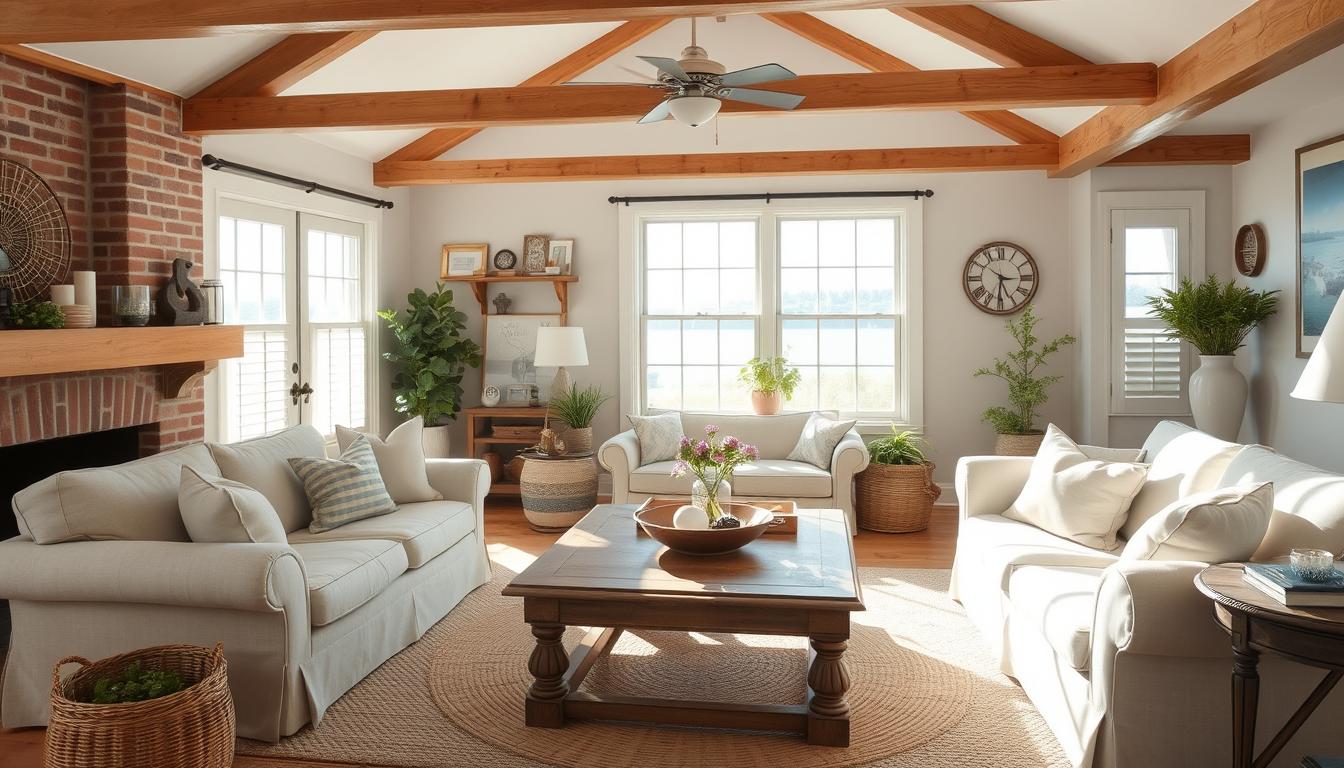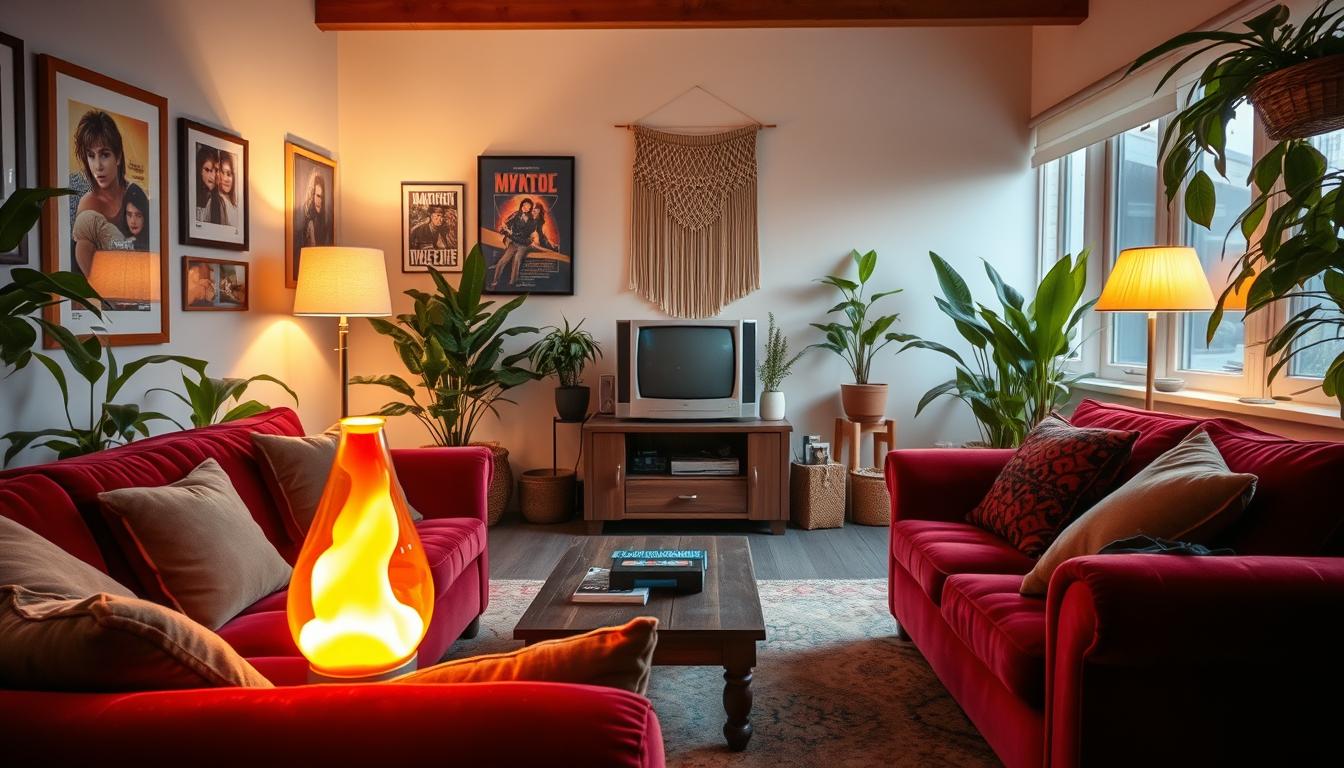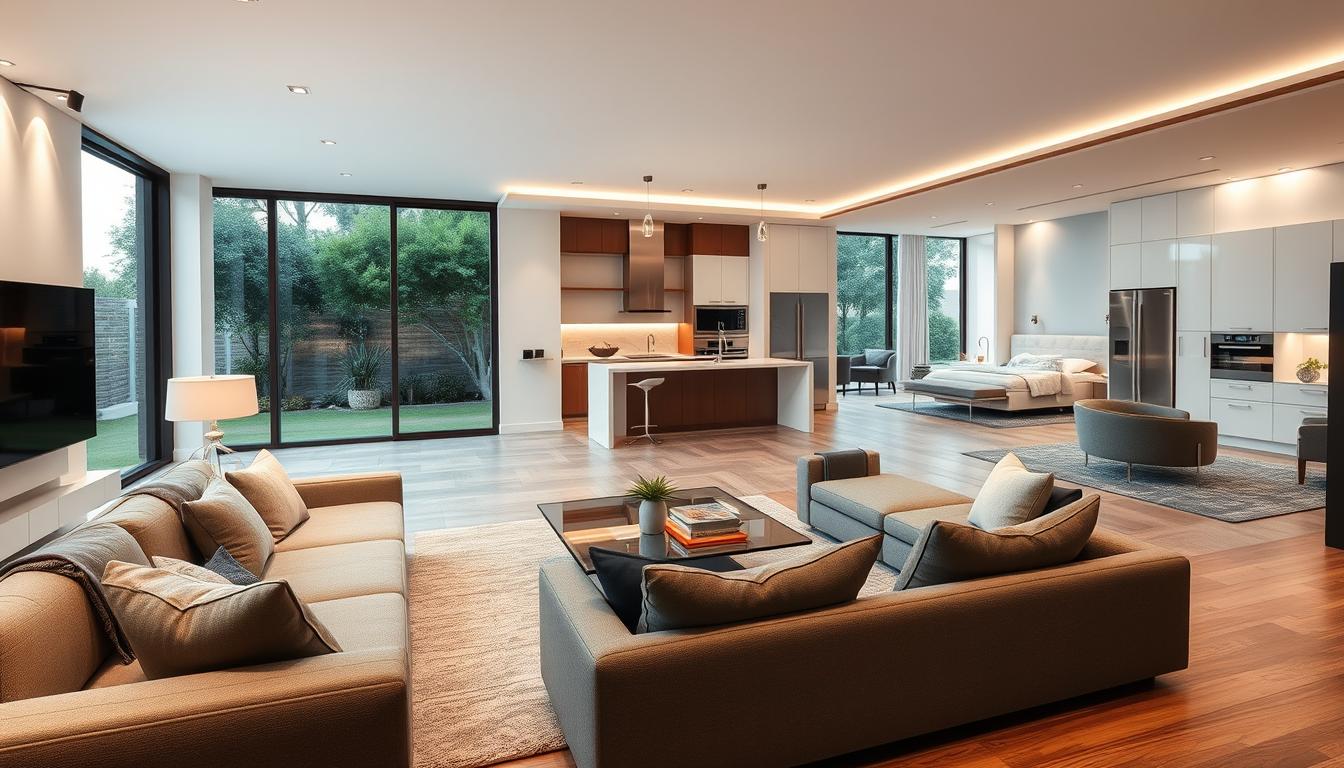The Cape Cod aesthetic has been a favorite in American home design for centuries. It brings the warmth and simplicity of New England’s coast to your home. Did you know over 70% of homeowners in the U.S. love this coastal style for its welcoming feel?
In this guide, we’ll dive into what makes the Cape Cod style special. We’ll cover its history and the design features that make it so popular. You’ll get tips on how to bring this timeless look into your home, making it warm and inviting.
Key Takeaways
- Understand the historical context and defining features of Cape Cod design
- Learn how to incorporate classic elements into your home decor
- Discover expert tips for achieving a warm and inviting Cape Cod style interior
- Explore the role of color, texture, and furniture in creating a cohesive look
- Gain insights into balancing traditional and modern elements
Introduction to Cape Cod Style Homes
In the harsh coastal climate of Cape Cod, Massachusetts, a distinct architectural style emerged. Cape Cod style homes are known for their simplicity, practicality, and cozy charm. They are a staple of traditional American architecture.
Brief History of Cape Cod Architecture
Cape Cod architecture dates back to the early colonial period. It was designed to withstand the harsh New England weather. Early Cape Cod homes were simple, rectangular, and centrally chimneys, with a steep roof to shed snow and a compact design to minimize exposure to the elements.
The style was also influenced by the region’s maritime history. It reflected the practicality and simplicity of the coastal lifestyle. Over time, Cape Cod homes became a beloved part of American architectural heritage, symbolizing a connection to the country’s colonial past.
Key Features of Cape Cod Style Homes
Cape Cod style homes are known for several key features. These include:
- Simple, unadorned facades
- Steeply pitched roofs to shed snow
- Central chimneys
- Multi-pane windows
- Clapboard or shingle siding
These elements not only provided practical solutions to the challenges posed by the coastal environment. They also contributed to the distinctive aesthetic of Cape Cod homes. The style’s emphasis on simplicity and functionality has made it a timeless choice for homeowners seeking a traditional yet unpretentious living space.
| Feature | Description | Benefit |
|---|---|---|
| Simple Facades | Unadorned exterior | Minimizes weathering |
| Steeply Pitched Roofs | Sheds snow efficiently | Reduces risk of roof collapse |
| Central Chimneys | Provides central heating | Warmth and efficiency |
Essential Elements of Cape Cod Interior Design
Cape Cod interior design focuses on natural materials, soft colors, and open spaces. It aims to create a calm, serene living area. This style mirrors the simplicity of Cape Cod’s natural beauty.
Natural Materials and Textures
Natural materials and textures are key in Cape Cod design. Wood, stone, and woven fibers add warmth and depth. They can be used in furniture, flooring, and decor.
Reclaimed wood can be used for wall paneling or furniture. Stone is great for fireplaces or feature walls. Woven fibers like jute or sisal add natural texture to rugs.
Color Palettes: Soft and Neutral Tones
A neutral color palette is central to Cape Cod design. Soft hues like whites, creams, and blues create a calming atmosphere. These colors are used on walls, furniture, and decor for a cohesive look.
To add depth, consider subtle texture variations or natural tones through throw pillows, blankets, or rugs. Below is a table of popular neutral color palettes:
| Color | Shade | Application |
|---|---|---|
| White | Soft Cream | Walls, Trim |
| Blue | Dusky Blue | Furniture, Accents |
| Gray | Light Gray | Rugs, Throw Pillows |
Open and Airy Spaces
Open and airy spaces are vital in Cape Cod design. This is achieved by reducing clutter, using sheer curtains, and maximizing natural light. The goal is to create a sense of freedom and flow.
To enhance openness, use multi-functional furniture and keep decor minimal. This maintains a clean, uncluttered environment that feels spacious and inviting.
Furniture Selection for Cape Cod Interiors
The Cape Cod style celebrates a relaxed, coastal lifestyle through furniture choices. It’s key to find furniture that’s both stylish and functional for a Cape Cod home.
Stylish yet Functional Furniture Pieces
Furniture in a Cape Cod interior should be both beautiful and useful. Look for pieces that do more than one thing, like a storage ottoman or a coffee table with storage. This keeps the space clean and uncluttered, a hallmark of the Cape Cod style.
Choose furniture with simple lines, little decoration, and a focus on comfort. Plush sofas and armchairs in neutral tones are great for a cozy feel. Also, make sure the furniture fits the room well to keep it feeling open and spacious.
Popular Furniture Styles
Cape Cod interiors often feature traditional or coastal-inspired furniture. Shaker-style furniture is a favorite for its simplicity and timeless look. Other good choices include rustic, beachy pieces made from natural materials like driftwood or wicker.
| Furniture Style | Characteristics | Ideal for Cape Cod |
|---|---|---|
| Shaker | Simple, clean lines, minimal ornamentation | Yes |
| Rustic | Natural materials, distressed finishes | Yes |
| Coastal | Light colors, beach-inspired elements | Yes |
Incorporating Vintage Finds
Vintage furniture can add charm and character to a Cape Cod interior. Look for items that match the coastal or cottage style, like vintage nautical decor or antique furniture with a worn look.
“Vintage furniture is not just about reusing old pieces; it’s about bringing history and character into your home.” – Interior Design Expert
When adding vintage pieces, make sure they fit with your current furniture and decor. Mixing old and new can make your space unique and welcoming.
Lighting in Cape Cod Style Homes
Lighting is key in Cape Cod style homes, making them warm and inviting. The right lighting can make these homes cozy and welcoming.
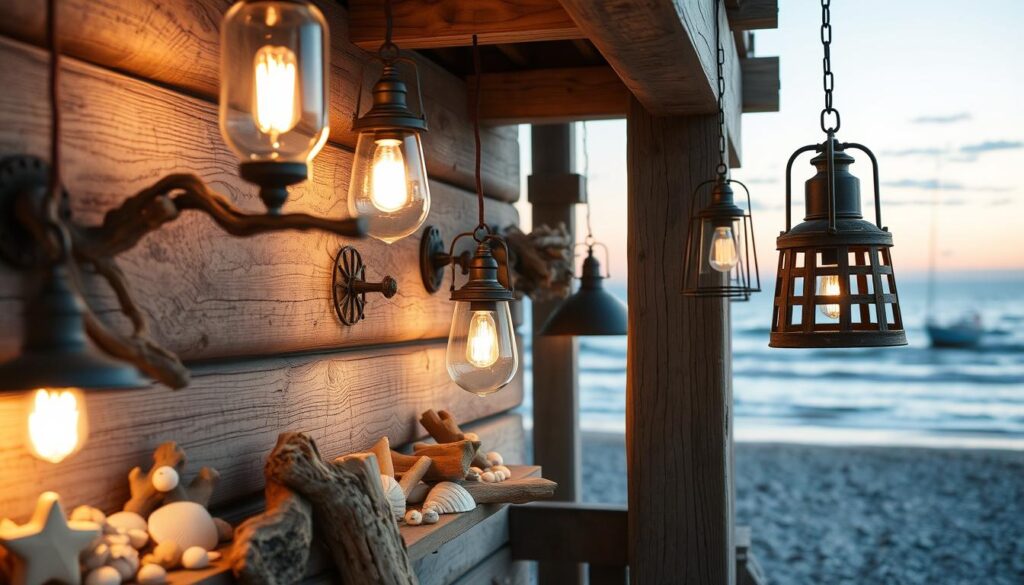
Understanding Coastal Lighting Fixtures
Coastal lighting fixtures reflect the simplicity and elegance of coastal living. They often use natural materials like wood, metal, and glass. This matches the Cape Cod look. Choose fixtures that look classic and timeless.
“The beauty of coastal lighting lies in its ability to bring the outdoors in, creating a seamless transition between indoor and outdoor spaces.” –
Emphasizing Natural Light
Cape Cod style homes love natural light. They use big windows and skylights to let in lots of light. This cuts down on the need for artificial light during the day. It saves energy and makes the home feel better.
- Use sheer curtains to filter natural light
- Install skylights or larger windows to increase natural illumination
- Keep window areas clear of clutter to allow natural light to flow freely
Choosing Warm and Inviting Bulbs
The type of bulb used can really change a room’s feel. For Cape Cod homes, warm bulbs like LED or incandescent with a soft white tone are best. They give a cozy glow that fits well with the home’s natural materials and colors.
By picking the right lighting, using natural light, and choosing bulbs wisely, you can make your Cape Cod home warm and inviting. This careful lighting choice will improve your home’s look and make it feel welcoming and comfy.
Textiles and Soft Furnishings
Making a cozy Cape Cod style home is more than just the right furniture. It’s also about the textiles and soft furnishings that add warmth and character. The right selection can make your home feel inviting and comfortable, embodying the essence of cottage style.
Rugs, Curtains, and Cushions
Rugs, curtains, and cushions are key to creating a cozy and inviting atmosphere in a Cape Cod style home. Choosing the right materials and patterns is crucial. For instance, rugs with natural fibers like jute or sisal can add warmth underfoot.
Curtains made from lightweight fabrics allow natural light to filter in, enhancing the airy feel of the space. When selecting cushions, consider fabrics that are soft to the touch and visually appealing. Nautical themes are common in Cape Cod decor, but it’s also important to balance these with more neutral tones to avoid overwhelming the senses.
Importance of Layering Textures
Layering different textures is a key strategy in achieving a rich and inviting interior. By combining smooth fabrics with rougher textures, you can create a visually interesting space that feels layered and cozy. For example, pairing smooth cotton curtains with a chunky woven rug can add depth to a room.
“Layering textures is about creating a sensory experience that makes your home feel welcoming and comfortable.”
Patterns to Consider
When it comes to patterns, Cape Cod style often incorporates classic motifs such as stripes and florals. These patterns can be introduced through various textiles like throw pillows, blankets, and even wallpaper. Stripes, in particular, are a staple of nautical decor, evoking the feeling of the sea.
| Pattern | Description | Best Use |
|---|---|---|
| Stripes | Classic nautical motif, often in blue and white | Curtains, throw pillows, rugs |
| Florals | Soft, natural designs that add a touch of elegance | Upholstery, wallpaper, bedding |
| Checks | Versatile pattern that works well in modern and traditional settings | Throw pillows, table runners, curtains |
By thoughtfully selecting and layering textiles and soft furnishings, you can create a Cape Cod style home that feels cozy, inviting, and authentically charming.
Incorporating Nautical Themes
Adding nautical themes to our Cape Cod interiors is about finding the right mix. It’s about blending coastal charm with elegant simplicity. Nautical elements are key in defining the Cape Cod style.
Marine-Inspired Decor Ideas
To bring the coast into our homes, we can use marine-inspired decor. This includes naval artifacts and ship wheels. We can also use coastal-colored glass and driftwood. The goal is to choose items that fit the coastal life without cluttering the space.
- Nautical charts and maps
- Anchors and ropes
- Seashells and starfish
- Coastal-themed artwork
Subtle Nautical Elements vs. Over-the-Top Themes
The challenge is to balance our love for nautical themes with avoiding too much. A bold, nautical-themed room might be tempting. But, a more subtle approach often leads to a more elegant design. A navy blue accent wall or rope details on furniture can add a coastal touch without being too much.
Some effective subtle nautical elements include:
- Using a coastal color palette
- Incorporating natural textures like wicker and jute
- Adding decorative accents that evoke the sea, such as shells or coral
By carefully adding nautical themes, we can make a Cape Cod style home that’s both genuine and stylishly simple.
The Role of Art in Cape Cod Style Interiors
Artwork is key in making a Cape Cod home truly yours. It turns a house into a cozy space that shows off your style. Art adds character and personality to your home.
Art makes a Cape Cod home special by adding a personal touch. It creates a unique atmosphere. The goal is to pick art that fits the Cape Cod look.
Choosing Artwork that Reflects the Aesthetic
To find the right art for your Cape Cod home, look for pieces that remind you of the coast. This could include:
- Seascapes or landscapes that evoke the feeling of the coast
- Abstract art that incorporates soothing colors reminiscent of the sea and sky
- Photography that captures the beauty of the coastal scenery
Local artists often make art inspired by the local environment. Their work can be traditional or modern, fitting many tastes.
Local Artists and Coastal Inspiration
Using art from local artists adds a special touch to your Cape Cod home. These artists draw inspiration from the coast, creating pieces that connect to the local culture and environment.
“The art of the coast is not just about the visual; it’s about evoking a feeling, a sense of place that connects us to the land and the sea.”
When picking art, think about these things:
- The color palette: Choose colors that match the coast, like blues, greens, and sandy neutrals.
- The theme: Pick art that shows the coastal theme, like nautical elements or landscapes.
- The style: Go for a style that you like, whether it’s modern, traditional, or abstract.
By carefully choosing art that fits the Cape Cod look and uses local inspiration, you can make your home more inviting. It will feel connected to the beautiful coastal environment.
Indoor Plants for a Coastal Feel
Indoor plants can bring natural beauty to your Cape Cod style home. They add a coastal charm and create a calming atmosphere.
Best Indoor Plants for Cape Cod Style
Choose indoor plants that thrive in coastal environments. They should have a natural, effortless charm. Some great options include:
- Succulents: These plants are perfect for coastal homes. They are adapted to dry conditions and need little care.
- Peace Lilies: Known for their elegant white blooms, peace lilies add a touch of serenity to any room.
- Boston Ferns: With their lush, green fronds, Boston ferns bring a natural, tropical feel to your indoor spaces.
For more inspiration, check out mid-century modern home interiors.
Arranging Plants for Natural Appeal
The way you arrange your indoor plants matters a lot. To get a natural, effortless look, follow these tips:
- Group plants together for a lush, verdant display.
- Use different planters and pots to add texture and interest.
- Place plants where they get the right light, whether bright or soft.
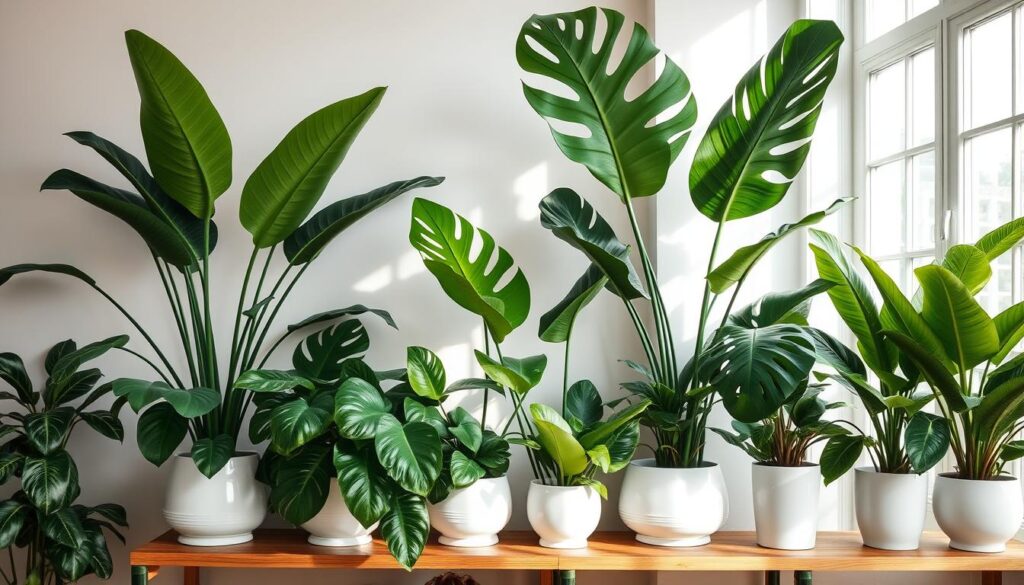
By adding indoor plants to your Cape Cod style home, you can enhance the coastal living experience. Enjoy a more serene, inviting atmosphere.
Outdoor Spaces and Their Connection to Interior Design
Outdoor spaces are key in enhancing Cape Cod style interior design. They help create a balance between indoors and outdoors. A well-designed outdoor area can greatly improve the look of a Cape Cod style home.
To link indoor and outdoor spaces, choose elements that match both areas. Using the same materials and colors inside and outside helps create a smooth transition.
Extending Living Areas with Outdoor Decor
To make your living areas bigger, add comfortable and stylish outdoor furniture. Choose weather-resistant wicker or recycled plastic furniture in neutral colors. This furniture will look good with your indoor decor.
- Match your outdoor furniture with your indoor style for a cohesive look.
- Add outdoor rugs and throw pillows for warmth and texture.
- Include a statement piece, like a vintage bench or modern sculpture, for interest.
As coastal living fans, we know how important it is to bring the outdoors in. Using natural materials and textures in both decor helps create a smooth flow between spaces.
Creating Inviting Patios and Porches
Patios and porches are key parts of Cape Cod style homes. They act as a bridge between indoors and outdoors. To make a patio or porch welcoming, consider these elements:
| Element | Description |
|---|---|
| Comfortable Seating | Opt for plush outdoor furniture with weather-resistant cushions. |
| Soft Lighting | Use string lights or lanterns for a cozy feel. |
| Greenery | Add potted plants or hanging baskets for a natural touch. |
Interior design experts say a well-designed outdoor space is like an extension of your indoor area. This is very true for outdoor spaces in Cape Cod style homes.
“The porch is a quintessential element of the Cape Cod house, serving as a transition zone between the house and the landscape.” –
By designing our outdoor spaces to match our interior, we can create a unified and welcoming living area. This reflects the essence of coastal living.
Maintaining the Cape Cod Aesthetic Over Time
To keep a Cape Cod style home charming, you need to pay attention to details. This style is known for its simplicity, use of natural materials, and cozy feel. To keep your home looking great, it’s important to know how to change decor with the seasons and care for natural materials.
Tips for Seasonal Decor Changes
Changing your decor with the seasons keeps your Cape Cod home inviting. Here are some tips:
- Spring: Use light, airy textiles and soft colors to welcome the new season.
- Summer: Add nautical touches and natural fibers to enhance the coastal feel.
- Autumn: Use warm, earthy tones and cozy throw blankets to make your home snug.
- Winter: Create a cozy feel with soft lighting and warm colors.
When changing decor, remember to keep the Cape Cod style in mind. Stick to simplicity, natural materials, and a neutral color scheme.
Caring for Natural Materials
Natural materials are key to the Cape Cod look. To keep them looking good, follow these care tips:
| Material | Care Tips |
|---|---|
| Wood | Dust often and polish now and then to keep the finish shiny. |
| Wicker/Rattan | Keep it away from direct sunlight and moisture. Dust gently with a soft brush. |
| Natural Fibers | Vacuum or shake out often. Clean stains right away. |
By following these tips, your Cape Cod home will stay warm and welcoming. It will always reflect the timeless beauty of this design.
Conclusion: Bringing it All Together
We’ve looked at what makes cape cod style homes special. From natural materials to nautical touches, these elements add charm. By using them, you can make a traditional home that feels warm and full of character.
Creating a Unified Space
To get a cohesive look, balance is crucial. Mix natural textures, soft colors, and stylish furniture. Think about how lighting, textiles, and art can boost your home’s look.
Personalizing Your Design
Even with traditional designs, add your own twist. Use vintage items, family treasures, or special artwork. This makes your cape cod style home uniquely yours.
By combining these elements, you’ll have a captivating cape cod style home. It will show off your style and offer a peaceful retreat for years.

